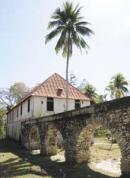- The Coffee Trails. A Universal Caribbean-Scented Heritage.
Coffee is one of today’s indispensable products for human consumption. It’s widely known for its stimulating values when it comes to coping with different physical or intellectual tasks; considered essential and cozy whenever you can enjoy its taste and aroma in a full and timely fashion. Just a sip or the simple invitation to have a good cup of coffee can unleash either a lively, nearly endless chat, or probably make way for a fierier and more passionate dialogue. Everything is possible under the delightful effects of a taste that can certainly turn the drinking of it into a genuine “miracle”.
The unmistaken magic of coffee, brimming with stories and legends, harks back to some centuries ago as the grain traveled through the Old World. The French were the ones who brought it to the New World, first to Martinique and then to Saint Domingue, from where –as a consequence of the Haitian Revolution- ended up on the island of Cuba, especially in the eastern region, covering a broad mountainous territory currently abutted by the Santiago de Cuba and Guantanamo provinces.
Coffee production in eastern Cuba was plentiful and highly efficient in the early 1800s, to such an extent that the island was from that moment on taken seriously as one of the world’s top producers. Consequently, the harvesting of coffee beans panned out to be one of Santiago de Cuba’s major powerhouses. The French presence brought along the implementation of a peculiar socioeconomic lifestyle in the rural outskirts of the city. The coffee plantation became a cultural landscape in which roads, farms and the vast assortment of productive components derived from the usage of illustrious thinking for the benefit of coffee paved the way toward higher quality.
Hundreds of coffee farmhouses dotted the mountains, an economic empire trapped in faraway and lavish scenery that quickly melted the peculiarities of the insular Caribbean nature into the ingrained niceties of growing coffee, cacao and a long list of other crops, including fruit trees, medicinal plants and ornamental shrubs. Quite a number of occasional visitors come to these farmhouses out of an invitation to make the most of this unique world and a majority of them are really stunned by the beauty of the scenery, the common wisdom applied to the productive processes and, above all, the reigning lifestyle.
As the 19th century rolled on, rifts between Spain and France accrued, coupled with the forced eviction of French settlers, the breakout of the independence wars launched by the Cuban people, and with the latter a kind of burn-and-slash action that eventually brought about the collapse of the colonial economy.
Those productive structures were jettisoned and tossed into oblivion, but as time went by into the 20th century, they eventually reemerged as part of the historic heritage. Several scientific and cultural institutions conducted a number of studies and logged the necessary compilations required by the World Heritage Committee to advance the Archeological Landscape registration. On November 29, 2000, the first coffee plantations of southeastern Cuba were recognized as World Heritage.
In 2015, the city of Santiago de Cuba will celebrate its fifth centennial, and it’s doing so by underscoring its entry into the World Heritage list by means of the Coffee Trails project, a far-reaching and embracing plan that will put a one-and-only historic and cultural heritage before the eyes of visitors and tourists, a project propped up by the principle of sustainability and designed for the benefit of the local population that, construed as its cultural recipient, is a major game changer of the productive and travel-oriented dynamics conceived here: the Fraternidad (Fraternity) Archeological Park.
The Office of the City Curator of Santiago de Cuba has joined hands with the European Union’s Malongo Foundation, universities and different cultural institutions to carry out this comprehensive, participative and inclusive project that lays bare –in the best sense of the expression- the very best of Santiago’s culture and its contribution to the universal values.
At the Franertidad Archeological Park, the coffee culture will depict the encounter with unforgettable stories and legends, told and lived out in their natural environment, right there where the Tumba Francesa rekindles chants and dances, and where the full view of the surrounding nature comes together with the unmistaken scent of a good coffee, the one from yesteryear and today, or better yet the one that will for always be tagged with good moments.



























































































































